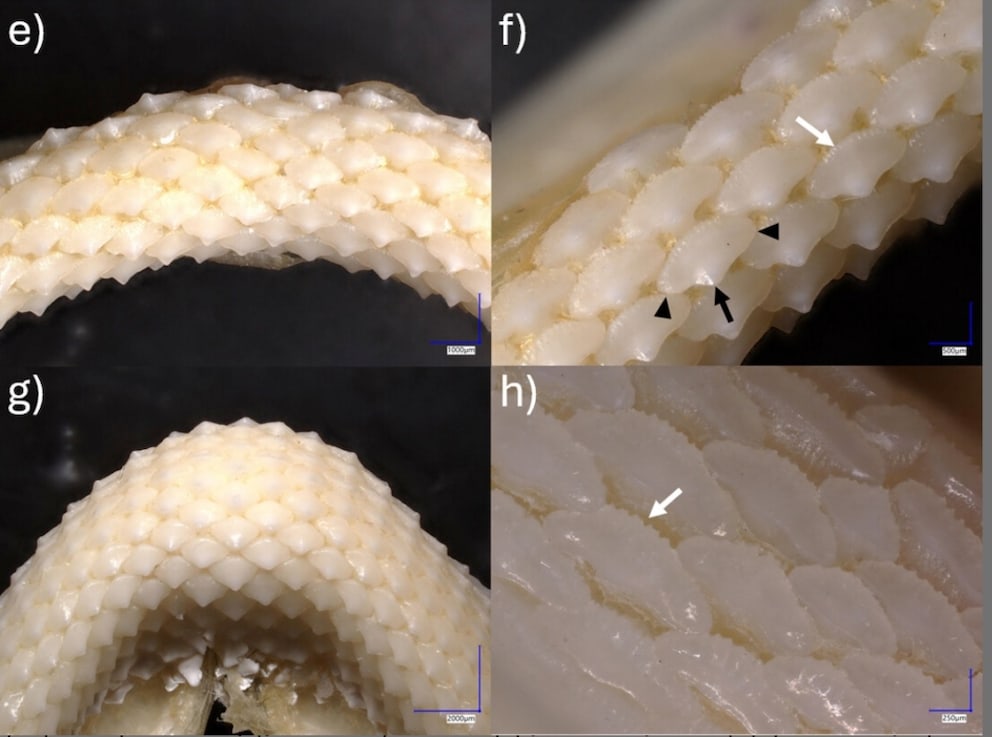March 28, 2025, 9:14 am | Read time: 5 minutes
Sharks were previously regarded as the silent hunters of the seas — but a small shark from New Zealand is breaking this silence. New research results show that the so-called “rig” (Mustelus lenticulatus) deliberately produces clicking sounds underwater. Why and how does it make these sounds? And could other shark species have similar abilities? A new study challenges a decades-old assumption — and raises exciting questions about communication in the animal kingdom.
A research team led by Tanja Schwamborn from the University of Auckland has documented for the first time that sharks can make targeted sounds. For a long time, the hunters of the seas were considered mute. However, the study published in the journal Proceedings of the Royal Society B shows that they can produce sounds: The New Zealand rig shark (Mustelus lenticulatus) produces short clicking sounds when being handled underwater. Until now, it was assumed that sharks — unlike many bony fish — do not use conscious vocalizations to communicate. This is the first study worldwide to document that sharks actively produce sounds. PETBOOK summarizes the exciting results.
So Much for Being Silent!
Fish are often thought of as silent creatures. But over 1000 species of bony fish are actually known to produce sounds. They use these sounds to find a partner, defend their territory, or warn off predators. On the other hand, cartilaginous fish like sharks, rays, and chimeras were thought to be relatively quiet, with any sounds observed being incidental by-products of movement or feeding.
This image has already been shaken in recent years, with the first reports of clicking rays making the rounds. The fact that a shark also makes such noises was more of an accidental discovery. This discovery was made with the rig shark, found in New Zealand’s coastal waters and commonly served as a fillet in fish and chips. However, the one-and-a-half-meter-long sharks are also popular research objects. It was noticed that the cartilaginous fish produced conspicuous clicks during handling. Schwamborn and her team wanted to investigate this in more detail and find out how and why the sharks make these noises.
The Clicking Noises Were Recorded in the Research Laboratory
The study investigated the clicking behavior of ten young rig sharks: five males and five females, each measuring between 55.5 and 80.5 centimeters in length. The clicking noises were recorded in a research laboratory. The sharks were manually restrained underwater for a maximum of 20 seconds. This standardized approach is also common in studies on other fish species. A total of 93 clicks were analyzed using a hydrophone and special software.
In addition, the team used micro-CT scans and microscopic analysis to examine the structure of the shark’s skull and teeth in order to gain clues as to the possible mechanism by which the sounds are produced.
How Do Sharks Produce Sounds?
All ten rig sharks produced clicking sounds during underwater handling, averaging nine clicks within 20 seconds. It was noticeable that the animals produced significantly more clicks in the first ten seconds than afterward. Most clicks also occurred simultaneously with body movements, such as bending sideways.
Morphological examinations of the animals’ skulls revealed a special tooth structure. This consisted of a mosaic pattern of interlocked, flat teeth, suggesting that the sharks might produce sounds through a snapping mechanism.

Shark Noises Could Serve as a Defense Mechanism
The study documents the active production of sounds in sharks for the first time. This is a significant finding, as it was previously assumed that sharks hear but do not produce sounds in a targeted manner. The fact that rig sharks produce clicks could indicate that other shark species also have similar abilities — especially species with a comparable tooth structure.
The researchers can only hypothesize why the frequency of clicks decreased as the experiment progressed. “Perhaps they were no longer afraid for their lives,” said study leader
Carolin Nieder, a researcher at the Woods Hole Oceanographic Institution, told the journal LiveScience. Loud clicking noises in the wild could serve as a split-second distraction for young sharks so that they can flee when a predator grabs them, the scientist added.
It Is Not Clear Whether Sharks Also Produce Sounds Under Natural Conditions
However, it remains unclear whether the sounds fulfill a communicative function. For example, they could serve as a deterrent to predators. Alternatively, the sounds might be an involuntary by-product of a defensive reaction.
In addition, the results come from controlled laboratory experiments in which the researchers restrained the animals under unnatural conditions. Whether the sharks also make the sounds under natural conditions and in communication with conspecifics remains to be seen. Further research is needed to answer this question.

In the Salish Sea Study shows that ship noise hinders orcas’ hunting

8500 gestures Chimpanzees communicate with sign language as fast as humans speak

Study shows Dogs understand slow speech better than fast speech
Why Sharks Make Sounds Requires Further Investigation
In the experiment, all sharks produced clicking noises. Nevertheless, the sample size of ten animals is quite small, and it makes it difficult to draw statistically robust conclusions. The authors also point out that the main frequency of the clicks lies outside the known hearing range of the rig sharks. This would argue against intraspecific communication.
However, the clicks do include low-frequency components that the cartilaginous fish might be able to perceive. Nevertheless, the researchers remain cautious in their interpretation: future studies will have to clarify whether these are meaningful signals or purely mechanical defensive behavior.

